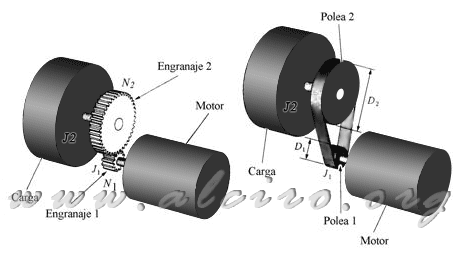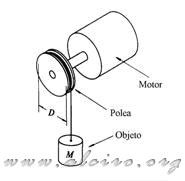5.1.5. Loads connected to the engine through transmission elements
The stepper motor provides a torque that comes in the form of rotary motion for positioning the load angle, but a large part of the charges require a linear positioning. There are different systems for processing and transmission of the movement that provides the engine, among these are the following.
5.1.5.1. Transmitted by belts and gears
When the engine torque is transmitted by belts or gears as shown in Figure 5.10, the load inertia is reflected in the motor according to the following terms:
^2\\ J\ =\ J_{1}+J_{2}*(\frac{D_{1}}{D_{2}})^2) (5.28)
(5.28)
where
J = total inertia equivalent to the motor shaft (Kg * m 2)
J1 = gear inertia on pulley 1 or 1 (Kg * m 2)
J2 = gear inertia on pulley 2 or 2 (Kg * m 2)
N1 = number of teeth of gear 1
N2 = number of teeth of gear 1
D1 = diameter of the pulley 1
D2 = diameter of the pulley 2

Figure 5.10. Torque transmission by gears or belt pulleys.
Transformation of the load torque:
\\ T\ =\ T_{1}*(\frac{D_1}{D_2})) (5.29)
(5.29)
where
T = equivalent motor torque (N * m)
T1 = load torque (N * m)
5.1.5.2. Lifting
When the engine up an object of mass M through a pulley inertia J1, the whole reflected in the motor inertia is:
 (5.30)
(5.30)

Figure 5.11. Lifting objects with tape.







